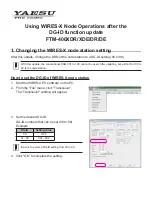
P a g e
|
38
20-62 VHF & UHF TRANSMITTER
Product Manual
Sea Air and Land Communications Ltd, 10 Vanadium Place, Addington, Christchurch 8024, New Zealand
March 2020
Glossary
Definition
ASCII: Acronym for "American standard code for information interchange," a 7 bit code
representing upper and lower case letters, numbers, punctuation, control codes, and other
special symbols. The term “ASCII” typically refers to the character set and control codes this
code represents.
SMA connector: A standard miniature RF connector. Not to be confused with “Reverse SMA”
often used with WIFI.
De-bounce: When a contact is switched it may make and break contact several times
before settling in its final state. To avoid repeated false triggers during the switching transition,
a “de-bounce” delay is added so that the no action is taken until the input has settled.
Duty cycle: The fraction of time that the transmitter is transmitting. Duty cycle is commonly
expressed as a percentage or a ratio.
POCSAG: A radio transmission standard for the on-air coding and signaling used for paging.
NRZ (Non-return-to-zero): Digital data that may remain in either a high or low state
indefinitely.
FSK: Frequency Shift Keying. A form of RF modulation where binary states are represented by
shifting the carrier frequency high or low.
RS-232: An electrical standard for the serial transmission of data.
Universal Serial Bus (USB): A common interface that enables communication between
devices and a host controller such as a personal computer (PC).
VSWR (Voltage Standing Wave Ratio): is a measure of how well the impedance of an antenna
or other RF load is matched to the nominal load impedance expected by a transmitter. For
correct performance a good match is required. A VSWR of 1:1 represents a perfect match.
Watchdog (timer): A regular event intended to monitor the performance of a system.
Typically an independent system would respond to the loss of a watchdog event to provide
an alert, activate a failsafe system, or attempt to recover from the fault.





































